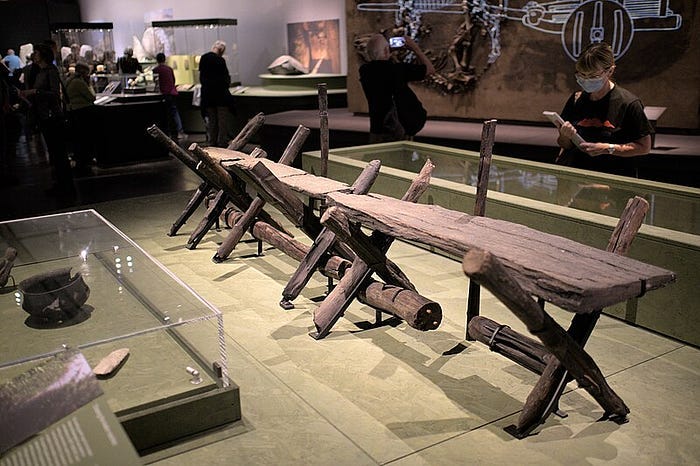The 6,000-Year-Old Neolithic Road Made Of Wood
England’s Sweet Track reminds us of humanity’s special relationship with wood

Humans have always had a special relationship with wood. In fact, the bond between us and this growing wonder material is so tight, that we can’t recognize its unique quality today. Call it one of those cases where the extraordinary blends into the ordinary over countless years.
For instance, I’d spend the summer weeks of my childhood at Atlantic City, New Jersey’s boardwalk, shuffling from one side to the other over the course of hours.
It never occurred to me this walkway is about five miles long and sixty feet wide. This “boardwalk” supports thousands of fellow walkers, bikers, shops, and even tram cars over its cumaru (Brazilian Teak) boards. Moreover, some form of this structure has existed for over a hundred years.
Now, this is where our familiarity obscures our uniqueness. Think about it. Wood literally grows out of the ground everywhere; it’s also cheap, durable, and strong. This wasn’t lost on our ancestors from their first encounters with wood.
Obviously, wood could become a tool or weapon. 300,000-year-old spears and sticks have been discovered, which are designed well enough to be thrown at surprising distances. But the connection is even older than our species.
Tom Metcalfe at Scientific American points out an almost 500,000-year-old year-old wooden structure has been found near a waterfall in Africa. The dating of the construction suggests it was built before the Homo Sapiens.
According to Metcalfe, the design shows a surprising level of sophistication:
“The ends of the two logs had been deliberately shaped to have large notches that could be fitted together like the wooden building toys Lincoln Logs…Other logs were laid across them to form a solid platform beside the river basin, perhaps for a fishing platform or a dwelling.”
In fact, even the idea of a “boardwalk,” which is so common today is an ancient concept. Neolithic people in England had their own. It’s called the Sweet Track and is one of the oldest causeways in the world — entirely made of wood.
An Amazing Find In A Bog
The Somerset Levels in Western England is a flat wetland that was once covered by a sea thousands of years ago. Recently, it became a source of peat. As diggers scoured for the resource, they found lots of wooden boards.
They appeared to be causeways covered up in the wetland over time. According to the Avalon Marshes Heritage site, local researchers began naming sections of these tracks after peat diggers, to encourage them to report their finds. Through the 1960s and 70s over forty tracks were found.
Perhaps the most famous was found by Ray Sweet, which became known as the Sweet Track.
This wooden walkway is thought to be two thousand feet long and four feet wide. Radiocarbon dating of the wood proved shocking. It showed the track was built in 3806 BC, so the pieces of this assembled footpath had been there for about six thousand years. But this wasn’t the only surprise.
Dr. Richard Brunning, an archeologist working with South West Heritage Trust says the mixture of peat and the watery environment preserved the wood to an amazing degree. He claims you can still see the cut marks by the builders’ stone axes.
Brunning says the Sweet Track had a dual role. It worked as a pathway across the wetlands but was also a place for ritual and sacrifice. He says arrowheads, bows, bowls, and even a jadeite axe head were found in the water by the track. They were likely offerings.
And the axe head had to be a special one. It was quarried in the Alps and moved for hundreds of years before it ended its trip in the Somerset Levels. Brunning explains the Sweet Track might be “the earliest ritual monument known from the UK.”
Its architecture also indicates a civilization of organized and capable builders with that all too familiar special relationship with wood.
How It Was Made
“The track is made of three basic components: planks made of oak, ash and lime, and rails and pegs made mainly of hazel and alder. The separate components were prepared on dry land and brought into the wet area.”
The builders of the track were Neolithic farmers, who cleared the dry land to plant farms and build homes. It also gave them access to the wood, that they cut with stone tools.
The construction itself is simple and clever. A base rail or pole was laid down in the water, sitting on the ground. Then two pegs were crossed over this bottom rail, forming an “x” shape, and a plank was jammed between the top ends. An additional peg came through this board, anchoring it.

The wood driven into the ground created a very stable base without a difficult assembly process.
Glyn Daniel in New Scientist reports archeologists Bryony and John Coles believe two hundred tons of wood were used to create the Sweet Track. It was cut and fashioned in a drier region, then brought to the wetland. But the preparation was much harder than the construction.
The two archeologists think the design is so simple, that a team of ten men could have built the track in a day if the materials were onsite.
Bryony also explains she found the hole in the top planks interesting. It’s present on most of the boards. In her article in New Scientist she explains it was worked in from both sides of the board with a stone axe, forming an hourglass shape.
It led some to believe it might be a mortise and tenon joinery (a slot edge that connects two pieces of wood), but Bryony never saw connection slots in other pieces of the wood. So, it may have been used as a way to drag the boards with rope, but more likely, an opening for a stabilizing peg.
As mentioned before, the Sweet Track isn’t the only ancient causeway hidden in the wetlands. One thirty years older, called the Post Track, was found not far away. So, the forty tracks found could be networks throughout the length of the wetlands.
However, it’s believed the Sweet Track itself was only in use for about ten years or so before it was abandoned, possibly due to rising water levels. But the local environment gives us a unique opportunity. It also reminds us of a special relationship, which outlives our species.
Our Timeless Special Relationship With Wood

I remember reading a story written by the Long Now Foundation about Oxford’s New College, which was built in 1379. Its dining hall had massive oak beams. About a hundred years ago, some of these original beams were damaged by an insect infestation, and they needed to be replaced.
As administrators looked for suitable oak to replace the material, they were given pleasant information by the school’s forester. Yes, they have a forester. He told them when the school was built, the designers planted oak trees in a nearby forest knowing those beams would eventually need to be replaced.
So, the replacements were waiting for about four hundred years.
That one story encapsulates humanity’s special relationship with wood. It sheltered us in its branches before we stood upright, then became our roofs as we started to think and build. Wood grew tall next to us as our brains blossomed, turning into the tools we needed.
Not only did it make a Neolithic road, but trees and their wood are a boardwalk in our evolution. We’re just so close to them now, it’s hard to see.
-Originally posted on Medium 10/7/23


